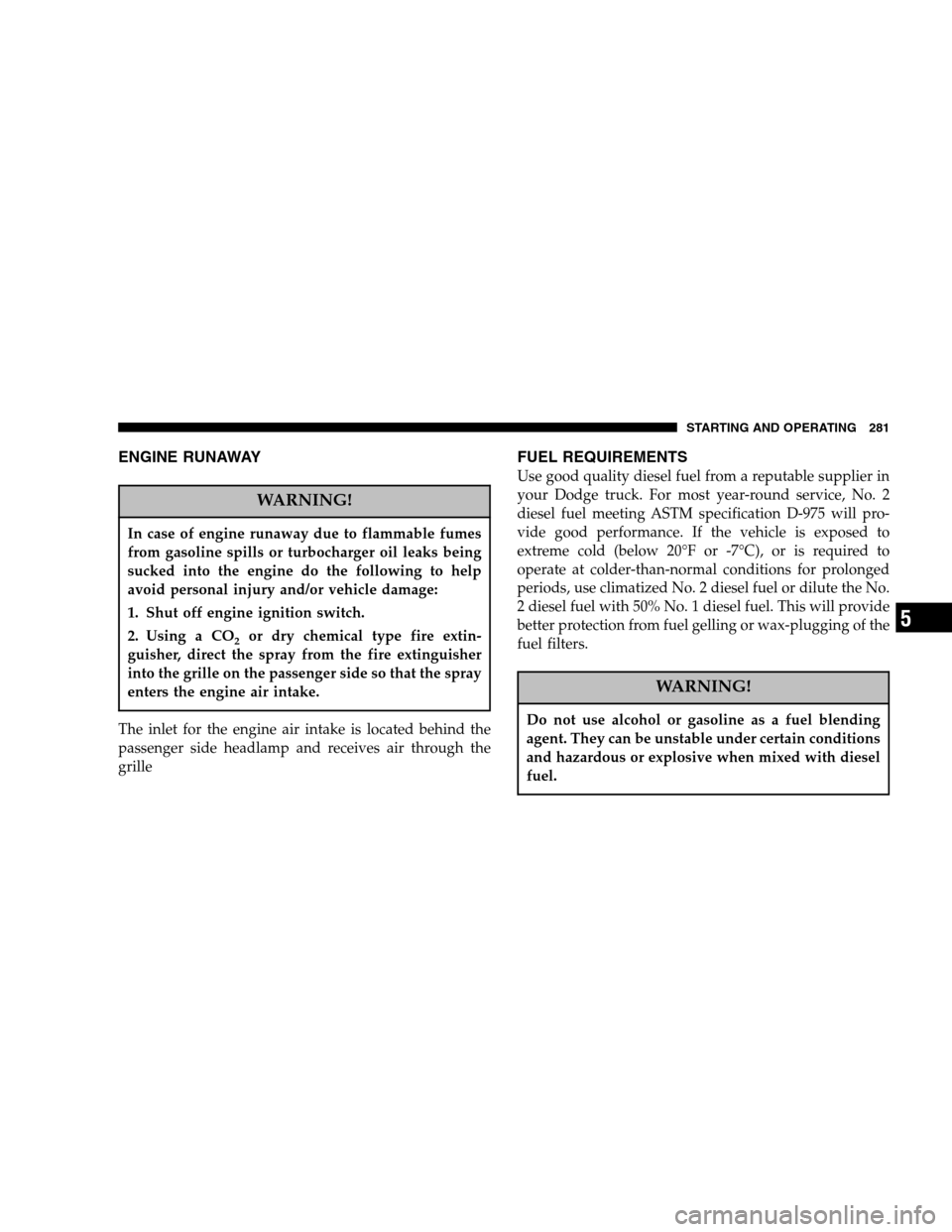Page 281 of 448

ENGINE RUNAWAY
WARNING!
In case of engine runaway due to flammable fumes
from gasoline spills or turbocharger oil leaks being
sucked into the engine do the following to help
avoid personal injury and/or vehicle damage:
1. Shut off engine ignition switch.
2. Using a CO
2or dry chemical type fire extin-
guisher, direct the spray from the fire extinguisher
into the grille on the passenger side so that the spray
enters the engine air intake.
The inlet for the engine air intake is located behind the
passenger side headlamp and receives air through the
grille
FUEL REQUIREMENTS
Use good quality diesel fuel from a reputable supplier in
your Dodge truck. For most year-round service, No. 2
diesel fuel meeting ASTM specification D-975 will pro-
vide good performance. If the vehicle is exposed to
extreme cold (below 20°F or -7°C), or is required to
operate at colder-than-normal conditions for prolonged
periods, use climatized No. 2 diesel fuel or dilute the No.
2 diesel fuel with 50% No. 1 diesel fuel. This will provide
better protection from fuel gelling or wax-plugging of the
fuel filters.
WARNING!
Do not use alcohol or gasoline as a fuel blending
agent. They can be unstable under certain conditions
and hazardous or explosive when mixed with diesel
fuel.
STARTING AND OPERATING 281
5
Page 298 of 448

Automatic Transmission Oil Temperature Warning
Light
All vehicles with heavy duty transmission oil cooling are
equipped with a transmission sump oil temperature
sensor and warning light. If elevated transmission tem-
peratures are encountered, the engine controller will
select the most desirable gear until the transmission
temperatures are reduced. If transmission oil tempera-
tures continue to rise, a warning light located in the
instrument cluster will illuminate. If this should occur,
stop the vehicle, shift to Neutral, and run the engine at
idle or faster until the light goes off.
Towing With An Automatic Transmission
Vehicles equipped with an automatic transmission may
shift into and out of Overdrive, or a lower gear, when
driving in hilly areas, when heavily loaded, or when
towing into heavy winds.When this condition occurs, press the “TOW/HAUL”
button or shift into a lower gear to prevent excessive
transmission wear and/or overheating, and to provide
better engine braking.
NOTE:Do not exceed the following RPM while manu-
ally downshifting:
•5.9L Diesel Engines 3200 RPM.
If your vehicle has an automatic transmission and you
tow a trailer frequently, change transmission fluid and
filter(s) according to Maintenance Schedule “B.”
SNOWPLOW
Snowplow Prep Packages are available as a factory
installed option. These packages include components
necessary to equip your vehicle with a snowplow.
NOTE:Before installation of a snowplow it is highly
recommended that the owner / installer obtain and
follow the recommendations contained within the Dodge
298 STARTING AND OPERATING
Page 335 of 448
MAINTAINING YOUR VEHICLE
CONTENTS
�Engine Compartment....................338
▫5.9L HO Cummins Turbo Diesel...........338
�Onboard Diagnostic System (OBD II).........339
�Replacement Parts......................339
�Dealer Service.........................340
�Service Information.....................340
�Maintenance Procedures..................343
▫Engine Oil..........................343
▫Drive Belt...........................348▫Engine Air Cleaner Filter................349
▫Draining Fuel/Water Separator Filter.......351
▫Maintenance Free Batteries...............354
▫Air Conditioner Maintenance.............355
▫Power Steering — Fluid Check............356
▫Front Suspension Ball Joints..............357
▫Steering Linkage — Inspection............357
▫Front Prop Shaft Lubrication.............358
7
Page 342 of 448

•If an engine has been operating and the coolant is hot,
allow the engine to cool before you slowly loosen the
filler cap and relieve the pressure from the cooling
system.
•To avoid burns, remember that the engine components
will stay hot after the engine is shut off.
•Do not use gasoline or other flammable materials to
clean parts. Always use approved cleaning solvents.
•Relieve all pressure in the fuel, oil and cooling systems
before any lines, fittings or related items are removed
or disconnected. Be alert for possible pressure when
disconnecting any device from a system that utilizes
pressure. Do not check for pressure leaks with your
hand. High pressure oil or fuel can cause personal
injury.
WARNING!
Do not open the high pressure fuel system with the
engine running. Engine operation causes high fuel
pressure. High pressure fuel spray can cause serious
injury or death.
•Important:All maintenance other than that listed in
this manual, as well as some procedures listed here,
MUSTbe performed by your local Dodge Truck
Dealer. Your authorized Dodge Dealer has been
trained and has the necessary parts to maintain your
engine.
342 MAINTAINING YOUR VEHICLE
Page 343 of 448

MAINTENANCE PROCEDURES
The pages that follow contain therequiredmaintenance
services determined by the engineers who designed your
vehicle.
Besides the maintenance items for which there are fixed
maintenance intervals, there are other items that should
operate satisfactorily without periodic maintenance.
However, if a malfunction of these items does occur, it
could adversely affect the engine or vehicle performance.
These items should be inspected if a malfunction is
observed or suspected.
Engine Oil
Checking Oil Level
To assure proper lubrication of your vehicle’s engine, the
engine oil must be maintained at the correct level. Check
the oil level at regular intervals. The best time to check
the oil level is before starting the engine after it has been
parked overnight. When checking oil after operating theengine, first ensure the engine is at full operating tem-
perature, then wait at least 15 minutes after engine
shutdown to check the oil.
Checking the vehicle while it’s on level ground will also
improve the accuracy of the oil level readings. Add oil
only when the level on the dipstick is below the “ADD”
mark. The total capacity from the low mark to the high
mark is 2 quarts (1.9 liters).
MAINTAINING YOUR VEHICLE 343
7
Page 344 of 448

Never operate the engine with oil level below the “ADD”
mark or above the upper “SAFE” mark.
Change Engine Oil
CAUTION!
Overfilling or underfilling the crankcase will cause
oil aeration or loss of oil pressure. This could dam-
age your engine.
Road conditions as well as your kind of driving affect the
interval at which your oil should be changed. Check the
following to determine if any apply to you:
•Frequent short trips where the engine does not achieve
full operating temperature (operating temperature de-
fined as 190° F (66° C) coolant temperature).
•Extensive engine idling (over 10 minutes per hour of
operation) at ambient temperatures less than 32° F (0°
C).
•Driving in dusty conditions.
•Frequent trailer towing.
•Taxi, police, or delivery service (commercial service).
•Off-road or desert operation.
•Extensive operation at high engine speeds (greater
than 2900 rpm) and loads (greater than 70% throttle).
IfANYof these apply to you, then change your engine oil
at every interval shown in schedule�B�of the�Mainte-
nance Schedules�section of this manual.
If none of these apply to you, then change your engine oil
at every interval shown on schedule�A�of the�Mainte-
nance Schedules�section of this manual.
344 MAINTAINING YOUR VEHICLE
Page 345 of 448
NOTE:Most vehicles are operated under the conditions
listed for Schedule�B.�
Engine Oil Selection
1. Engine Oil Quality
Use only oils conforming to API Ser-
vice CI-4. A sulfated ash limit is speci-
fied for lubrication oil used in Cum-
mins engines. Oils with a high ash
content may produce deposits on
valves that can progress to guttering
and valve burning. A maximum sul-
fated ash content of 1.85 mass % is recommended for all
oil used in the engine.
2. Engine Oil Viscosity (SAE Grade)
The proper SAE viscosity of engine oil for the expected
ambient temperature range should be selected, as indi-
cated in the following chart:NOTE:The same oil change interval is to be followed
for synthetic oil as for petroleum based oil. Also, syn-
thetic oil must meet the same performance specifications
as petroleum oil.
MAINTAINING YOUR VEHICLE 345
7
Page 346 of 448

Engine Oil Filter
Refer to Recommended Fluids, Lubricants and Genuine
Parts for the correct part number. The engine oil filter
should be changed ateveryengine oil change.
Engine Oil And Filter — Change
WARNING!
Hot oil can cause personal injury.
Operate the engine until the coolant temperature reaches
140°F (60°C). Shut the engine off. Remove the oil drain
plug.
Use a container that can hold at least 12 quarts (11.3
Liters) to hold the used oil.Always check the condition of the used oil. This can give
you an indication of some engine problems that might
exist.
•Thin, black oil indicates fuel dilution.
•Milky discoloration indicates coolant dilution.
Clean the area around the oil filter base. Remove the filter
from the underside of the vehicle using a cap style oil
filter wrench.
Clean the gasket surface of the filter mount. The filter
gasket can stick on the filter mount. Make sure it is
removed.
Change the engine oil filter with every engine oil change.
Only a high quality MOPAR filter should be used to
assure most efficient service.
346 MAINTAINING YOUR VEHICLE